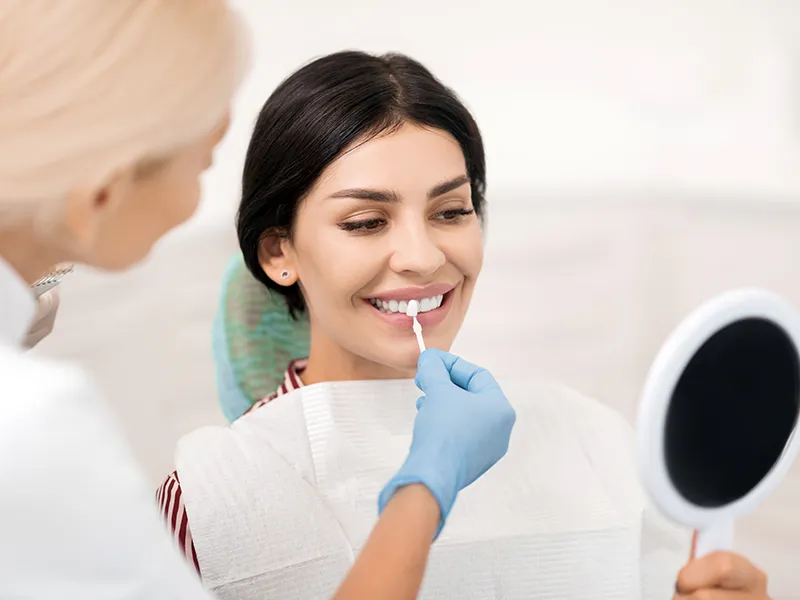What is Teeth Whitening Oasis?
Teeth whitening oasis refers to the pursuit of a brighter, more confident smile through various methods designed to lighten the color of your teeth. It’s about more than just aesthetics; it’s about boosting your self-esteem and making a positive first impression. With a dazzling smile, you can feel more empowered in social and professional settings. The ‘oasis’ aspect suggests a haven where you can rejuvenate and revitalize your smile, turning to proven and effective techniques to achieve the desired results. The term encompasses a variety of techniques, ranging from professional procedures to at-home remedies, each tailored to different needs and preferences, forming an all-encompassing approach toward attaining a brilliant, white smile.
The Science Behind Teeth Whitening
Understanding the science behind teeth whitening is essential for making informed choices. Tooth discoloration occurs due to a variety of factors, including the natural aging process, staining from foods and drinks, and the use of tobacco products. The enamel on our teeth contains microscopic pores that can absorb stains over time. Teeth whitening methods typically work by using bleaching agents, such as hydrogen peroxide or carbamide peroxide. These agents penetrate the enamel and dentin, breaking down the stain molecules and effectively lightening the tooth’s appearance. The concentration of the bleaching agent and the duration of its application determine the degree of whitening achieved. Various factors, like the type of stain and the individual’s tooth structure, also influence the effectiveness of the process. Consulting a dentist is recommended to assess suitability and expectations.
How Teeth Whitening Works

Teeth whitening generally involves the application of bleaching agents to the surface of the teeth. These agents, most commonly hydrogen peroxide or carbamide peroxide, act as oxidizing agents. When applied, they release oxygen molecules that react with the stain molecules within the enamel and dentin, effectively breaking them down. This process doesn’t remove the enamel; instead, it alters the color of the existing tooth structure. The process can be accelerated with the use of specialized lights or lasers in professional settings. The effectiveness of the process depends on the concentration of the bleaching agent, the duration of the treatment, and the method used. At-home kits typically use lower concentrations, while in-office treatments offer higher concentrations, yielding faster and more dramatic results. The overall goal is to lighten the teeth several shades, providing a brighter and more youthful appearance.
Different Methods of Teeth Whitening
The methods available for teeth whitening are diverse, catering to different preferences, budgets, and desired results. These methods range from professional treatments to over-the-counter products, each with its own set of advantages and considerations. Professional options, conducted by dentists, often provide the most dramatic and immediate results, utilizing higher concentrations of bleaching agents and advanced technologies. At-home kits, including custom-fitted trays and whitening strips, offer a more convenient and cost-effective alternative. Whitening toothpastes and rinses, although less potent, can help maintain the results and prevent future staining. The choice of method depends on individual needs, the extent of discoloration, and the desired level of whitening. It’s crucial to consult with a dental professional to determine the most appropriate and safe approach for your specific situation.
Professional Teeth Whitening Options
Professional teeth whitening, performed in a dental office, offers several advantages, including faster results and higher concentrations of bleaching agents. In-office procedures often involve the application of a high-concentration hydrogen peroxide gel to the teeth, followed by the use of a special light or laser to accelerate the whitening process. This can lighten teeth by several shades in a single session, providing immediate and noticeable improvements. Dentists can also address any pre-existing dental issues or sensitivities before starting the treatment, ensuring a safe and effective process. The professional setting allows for precise monitoring of the procedure and the ability to manage any potential side effects, such as tooth sensitivity. Professional whitening provides the most powerful and controlled approach to achieve a dramatically brighter smile, often customized to the individual’s specific needs.
In-Office Teeth Whitening

In-office teeth whitening is the most immediate way to achieve a significantly brighter smile. The procedure typically involves the dentist applying a high-concentration bleaching gel to the teeth. This gel, usually containing hydrogen peroxide, is carefully applied to the surface of the teeth, ensuring even coverage. To enhance the whitening effect, a special light or laser is often used to activate the bleaching agent. This light energy accelerates the breakdown of stain molecules, resulting in faster and more dramatic results. The dentist closely monitors the process, ensuring patient comfort and addressing any sensitivity. The entire process usually takes about an hour, and the results are visible immediately after the procedure. In-office whitening is ideal for those seeking quick, impactful results under professional care. It’s also a good choice for people with more severe stains or discoloration.
At-Home Teeth Whitening Kits
At-home teeth whitening kits provide a convenient and cost-effective alternative for achieving a brighter smile. These kits typically include custom-fitted trays or pre-filled whitening strips containing a lower concentration of bleaching agent, usually carbamide peroxide. The custom trays, designed by a dentist, provide a better fit, ensuring even coverage and minimizing the risk of gum irritation. Whitening strips are easy to use, adhering directly to the teeth for a specified amount of time. The at-home process generally requires wearing the trays or using the strips for a set duration each day or night, over a period of several days or weeks, depending on the product and desired results. While less potent than professional treatments, at-home kits offer noticeable improvements and can be a great option for maintaining results. Consulting your dentist can help determine which product best suits your needs and ensures safe usage.
Whitening Toothpastes and Rinses
Whitening toothpastes and rinses are readily available options for those looking to maintain or slightly enhance the brightness of their teeth. These products contain mild abrasives and/or chemical agents that help remove surface stains. Whitening toothpastes typically contain abrasives like hydrated silica or calcium carbonate, which gently polish the teeth, removing stains caused by foods and drinks. Whitening rinses often contain hydrogen peroxide, a bleaching agent that can contribute to a brighter appearance. While these products are less effective than professional treatments or at-home kits, they can help remove surface stains and prevent new ones from forming, thereby contributing to overall oral hygiene and a brighter smile. Consistent use, along with proper brushing and flossing, can help maintain the results of more intensive whitening treatments and keep your teeth looking their best.
Choosing the Right Teeth Whitening Method

Choosing the right teeth whitening method depends on several factors, including your current oral health, the extent of discoloration, your budget, and your desired results. If you’re looking for immediate and dramatic results, professional in-office whitening is the best option. This provides the most powerful treatment under the supervision of a dentist. For a more convenient and budget-friendly approach, at-home whitening kits, including custom trays or strips, are excellent choices. These offer visible improvements with consistent use. Whitening toothpastes and rinses are suitable for maintaining brightness and removing surface stains, acting as a supplementary measure. Consulting with a dentist is crucial to assess your oral health and determine the most appropriate and safe method for your specific needs and expectations, thus ensuring optimal outcomes and minimizing potential risks.
Factors to Consider Before Whitening
Before undergoing any teeth whitening procedure, several factors should be considered. The presence of existing dental work, such as fillings, crowns, or veneers, is crucial. Whitening treatments do not affect these restorations, meaning they will not change color, potentially resulting in a mismatch with your newly whitened natural teeth. Assessing the health of your teeth and gums is equally important. Any cavities, gum disease, or other dental issues should be addressed before starting any whitening treatment to prevent complications. Sensitivity levels are another factor, as some individuals may experience temporary tooth sensitivity during and after whitening. Consulting a dentist allows for a thorough evaluation of your oral health, helping you understand the potential outcomes and make informed decisions. This consultation will also ensure that the chosen method is appropriate and safe for your specific oral condition.
Consulting with a Dentist
Consulting with a dentist before starting any teeth whitening treatment is highly recommended. A dentist can assess your oral health, identifying any underlying issues like cavities or gum disease that need to be addressed first. They can also determine the cause of the discoloration and recommend the most suitable whitening method for your specific needs. The dentist can evaluate your teeth’s sensitivity levels and inform you about potential side effects, such as temporary discomfort. Additionally, they can provide custom-fitted trays for at-home whitening kits, ensuring better results and reducing the risk of gum irritation. Regular dental check-ups are also an excellent way to monitor your oral health and ensure that the whitening treatment is progressing safely. Consulting with a dentist is essential for achieving the best results while safeguarding your oral health.
Maintaining Your Bright Smile

Maintaining your bright, white smile requires ongoing care and attention. Regular dental check-ups and professional cleanings are essential for removing plaque and preventing stains. Brushing twice a day with a whitening toothpaste and flossing daily helps to remove surface stains and promote overall oral hygiene. Consider using a whitening mouthwash to further enhance the results and prevent future staining. Avoiding or limiting the consumption of staining foods and drinks, such as coffee, tea, red wine, and dark-colored berries, is equally important. If you do consume these items, rinsing your mouth with water immediately afterward can help minimize staining. Regular touch-up treatments, either at home or in the dentist’s office, can help maintain your desired level of brightness. Prioritizing good oral hygiene habits and being mindful of what you consume can help you enjoy a dazzling smile for longer.
Tips for Long-Lasting Results
To ensure the longevity of your teeth whitening results, it’s crucial to adopt certain habits. Minimize or avoid the consumption of staining foods and drinks, such as coffee, tea, red wine, and dark sauces. If you consume these items, rinse your mouth with water immediately afterward. Avoid tobacco products, as they can severely stain your teeth and diminish the results of whitening treatments. Maintain excellent oral hygiene by brushing your teeth twice a day with a whitening toothpaste, flossing daily, and using a whitening mouthwash. Consider using a straw for beverages that can stain your teeth, as it helps minimize direct contact with the teeth. Schedule regular dental check-ups and professional cleanings, as your dentist can provide touch-up treatments and advice on maintaining your bright smile. By adhering to these practices, you can extend the life of your teeth whitening results and keep your smile looking its best.
Foods and Drinks to Avoid
Certain foods and drinks can stain teeth and compromise the results of whitening treatments. Coffee, tea, and red wine are notorious for causing discoloration due to their strong pigments. Dark-colored sodas, such as cola, and fruit juices, especially those from berries, can also contribute to staining. Foods like soy sauce, balsamic vinegar, and curries contain pigments that can adhere to the enamel and cause stains. Tobacco products are a significant culprit, as they contain nicotine and tar, which stain teeth and can also damage overall oral health. It’s important to be mindful of what you consume and to limit or avoid these staining agents. If you do consume these items, consider rinsing your mouth with water immediately afterward and brushing your teeth to remove any potential staining. Adopting these strategies will help to protect your bright smile.
Oral Hygiene for a Sparkling Smile

Maintaining excellent oral hygiene is crucial for achieving and sustaining a sparkling smile. Brush your teeth twice a day, using a soft-bristled toothbrush and a whitening toothpaste. Brush for at least two minutes each time, ensuring that you reach all surfaces of your teeth. Floss daily to remove plaque and food particles from between your teeth and along the gum line, where your toothbrush can’t reach. Consider using a fluoride mouthwash to further protect your teeth from decay and enhance your breath. Regular dental check-ups and professional cleanings are essential for removing plaque and tartar buildup, and for monitoring your overall oral health. Consistent oral hygiene habits not only contribute to a brighter smile but also help prevent dental problems such as cavities, gum disease, and bad breath, leading to a healthier and more confident you. Implement this for a bright and healthy smile.
